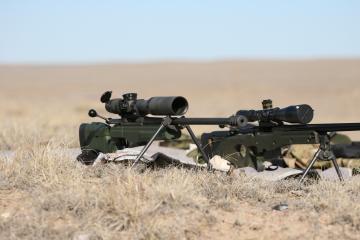
 Part of the challenge of extreme long-range shooting is getting a good sight
picture. The standard silhouette is visible 3.5 mils right and 1 mil below the
reticle center ranges at 1520 yards.
My shooting partner Ray has owned a TRG-42 for two years and has about 2000
rounds through it. After making first-round hits at long-range with his rifle,
I was convinced that I needed a Lapua as well. To maintain weapons-system
continuity with my .30 and 6.5 mm caliber precision rifles, I went with the
rifle from Accuracy International.
I equipped the AWSM with a Schmidt and Bender 5-25x56mm Precision Marksman II
scope, using the 28-MOA single-piece AI scope mount. The S&B has a first focal
plane P4-Fine reticle, which provides hash marks every one-half mil. The knobs
have 0.1-mil clicks, and the elevation knob can be dialed up 26 mils (or 260
clicks) from its zero-stop at 100 yards. Depending on atmospheric conditions
such as pressure and temperature, the .338 Lapua needs anywhere from 12 to 16
mils dialed to get to 1500 yards, so this scope setup gets the job done for the
Lapua.
Ray's TRG-42 is set up with a 20 MOA Picatinny base from Warne Manufacturing, upon
which is mounted a U.S. Optics (USO) SN3 3.8-22x44 mm scope, in beefy 34 mm USO
rings. Its elevation knob provides about 70 minutes up from a 100-yard zero,
with 0.5-MOA clicks. The S&B has 20 minutes more elevation than the SN3, but
both scopes can take the .338 Lapua to 1700 yards without running out of clicks.
The most common military ammunition for the .338 Lapua is the B408 "Lock Base"
250-grain FMJ load from Lapua. Armor-piercing (AP) and armor-piercing
incendiary (API) loads are also available. Lapua's other 250-grain bullet is

 Both rifles are capable of fantastic long-range performance. The bottom group
comprised five rounds from the AWSM in four inches at 940 yards. The TRG-42
shot three rounds into three inches in the top group at the same distance before the scope base
came loose.
the Scenar, which has a higher ballistic coefficient (BC) than the Lock Base, at
0.675 compared to 0.662. The other popular long-range bullet for the .338 Lapua
is the 300-grain SMK, which has a BC of 0.760. Sierra recommends a twist of one
in ten inches for the heavy SMK, so it is not a viable choice for the TRG
(1:12). The AWSM has a twist of one in eleven inches, which stabilized the
300-grain MatchKing in all of our testing and yielded substantially less wind
drift beyond 1000 yards than the Scenar.
For the last year, we have been shooting these rifles side by side at targets
out to 1600 yards, with a keen interest to determine which rifle is more
accurate. The summary is that they shoot basically the same. Both will shoot
one-hole groups at 100 yards, and both can shoot sub-half-MOA at 1000 yards if
the shooter knows what he's doing and conditions are favorable. The same
long-range drop-data can be used interchangeably with both rifles. Even the
same reloads shoot about the same in both rifles. In working up a recipe to
duplicate the factory Lapua 250-grain Scenar, we both eschewed H1000 due to
dispersion at 1000 yards and gravitated towards using H4831SC or Retumbo. Ray
shoots a little better than I do, and his groups show it with either rifle, but
it's hard to argue with five shots into four inches at just over half a mile.
Once you get past cosmetic differences, the two rifles are very similar in
design: both have short-throw bolts; both use five-round detachable magazines;
both have a closed-top receiver connected directly to an aluminum frame with

 The TRG-42's bipod connects to the stock much closer to the bore axis and its
feet spread wider, but it is slower to deploy and adjust than the AI bipod.
plastic stock skins over the top; both have adjustable two-stage triggers; and
both have adjustable ergonomics. We are left with a series of relatively minor
differences, some of which are matters of personal preference.
The TRG bipod is without question more stable than the AI bipod; it connects to
the stock much closer to the bore axis and its feet spread wider. The AI bipod
produces a more "floppy" rifle, but it is quicker to stow, deploy, and adjust,
and all of those can be done one-handed versus two-handed with the TRG bipod.
A .338 Lapua shooter can afford to take a few extra seconds to produce a stable
shooting position, so this is a clear advantage of the TRG.
The trigger on the TRG is a little crisper than the AI trigger. The magazine
release on the AI is a little easier to operate. The barrel on the AI is
end-user switchable with the factory barrel-change kit. The AI has less recoil
than the TRG because it weighs more than the TRG. This is especially noticeable
when the suppressor is mounted. The TRG cannot reliably stabilize the 300-grain
SMK, which is a better bullet for ultra-long-range shooting than the 250-grain
Scenar; the AWSM can.
|